Many of you might recall the ongoing saga with our neighbors—the ones who hired (and I use that term loosely) a so-called logger to clear-cut their property and, in the process, take down 15 of our trees. It was brutal. The woods, once a natural boundary, were suddenly gone, and the landscape changed overnight. Even now, the scars remain.
Some of the stumps have begun to recede, and while the land no longer looks like an oozing open wound, it still feels raw—scabbed over, but not yet healed. It’s a constant reminder of what was lost.
A few weeks ago, during one of my monthly Q&A calls (maybe you’d like to join our sessions?), someone asked me how things have progressed since The Great Tree Massacre. And I realized that, despite everything, there is some hope springing up.
I’ve not forgiven my neighbors—nor do I expect to. The husband, in particular, is an arrogant buffoon, the kind of guy who mansplains forestry while standing in the middle of his own hot mess of a landscape. He actually had the nerve to suggest that if I, too, deforested our six acres, I could have a “nice place.” Mind you, he has never actually seen my garden—he said this while standing proudly over his own wasteland, a barren hillside stripped of every living thing, like the setting of a dystopian novel where all the trees died for no reason at all.
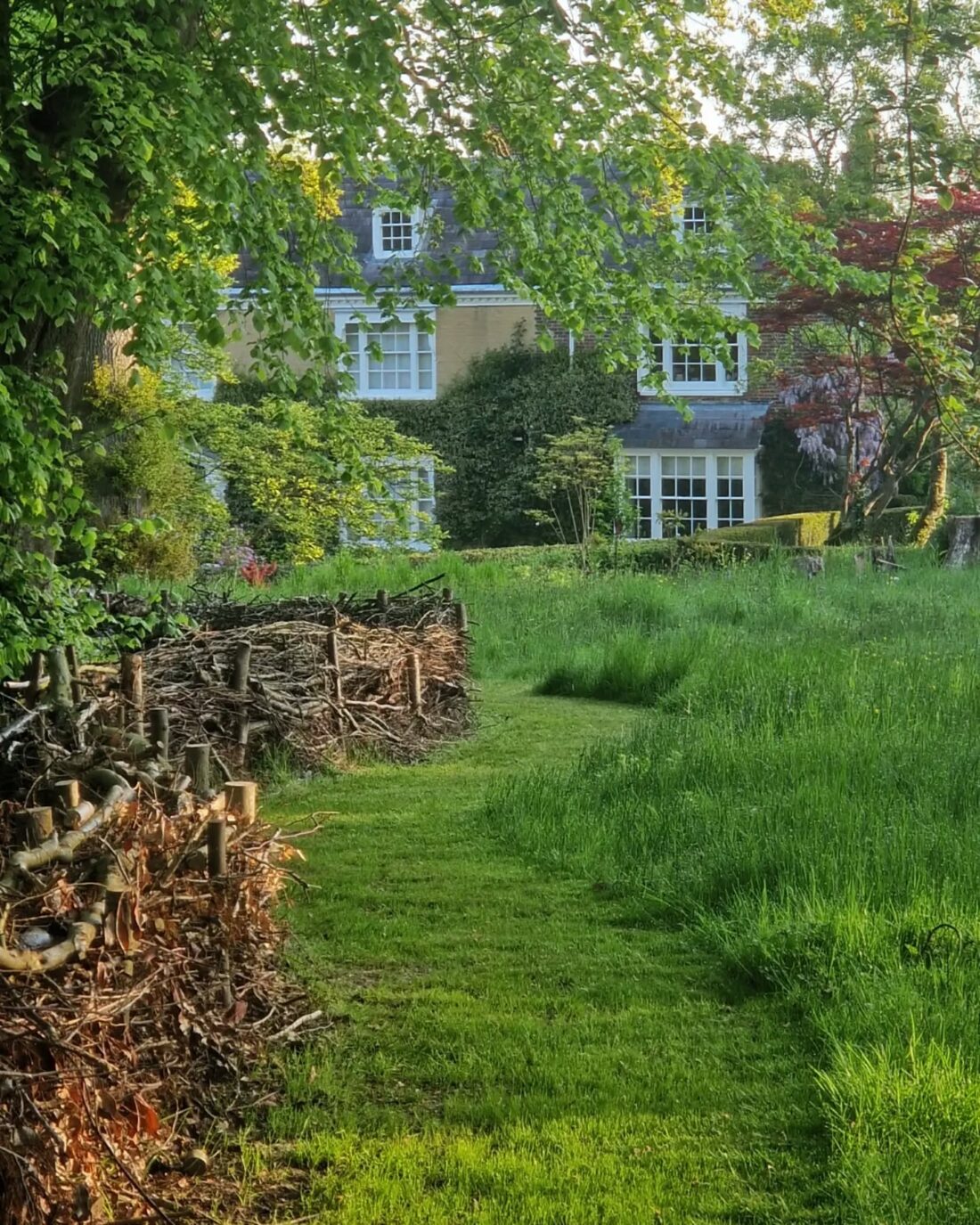
I wished I had a cuttingly clever retort (the kind that comes a few hours too late), something to match the sheer absurdity of this guy, but honestly, it’s been almost a year since treemageddon, and he still makes me so angry, I can’t even think straight. Imagine someone burning down your house and then casually suggesting you bulldoze what’s left to build something nice.
But rage isn’t a landscape strategy. Since then, I’ve been working on two things:
- Making something out of this barren hillside – I’m obsessed with planting scrub oaks (Watch for another post about how and why)
- Creating distance—visually and emotionally—from these neighbors.
It wasn’t just the loss of the trees that stung. The logger cleaned up nothing. He was only interested in the central trunks of the trees he stole from us—leaving behind a massive tangle of branches, limbs, and debris. It was like a final insult, adding injury to injury.
My husband and I have spent days—many, many days—gathering debris and fashioning it into a dead hedge. There are still countless hours of work ahead, but the process itself has turned out to be oddly therapeutic. There’s something deeply satisfying about turning destruction into creation, about reclaiming the mess and shaping it into something intentional. And since the hedge follows our property line, I can’t deny the satisfaction of creating a clear and undeniable boundary between us and them.
It’s slightly passive-aggressive—but honestly, I can’t come up with anything more aggressive that’s also constructive. And the more I build, the more I love it.
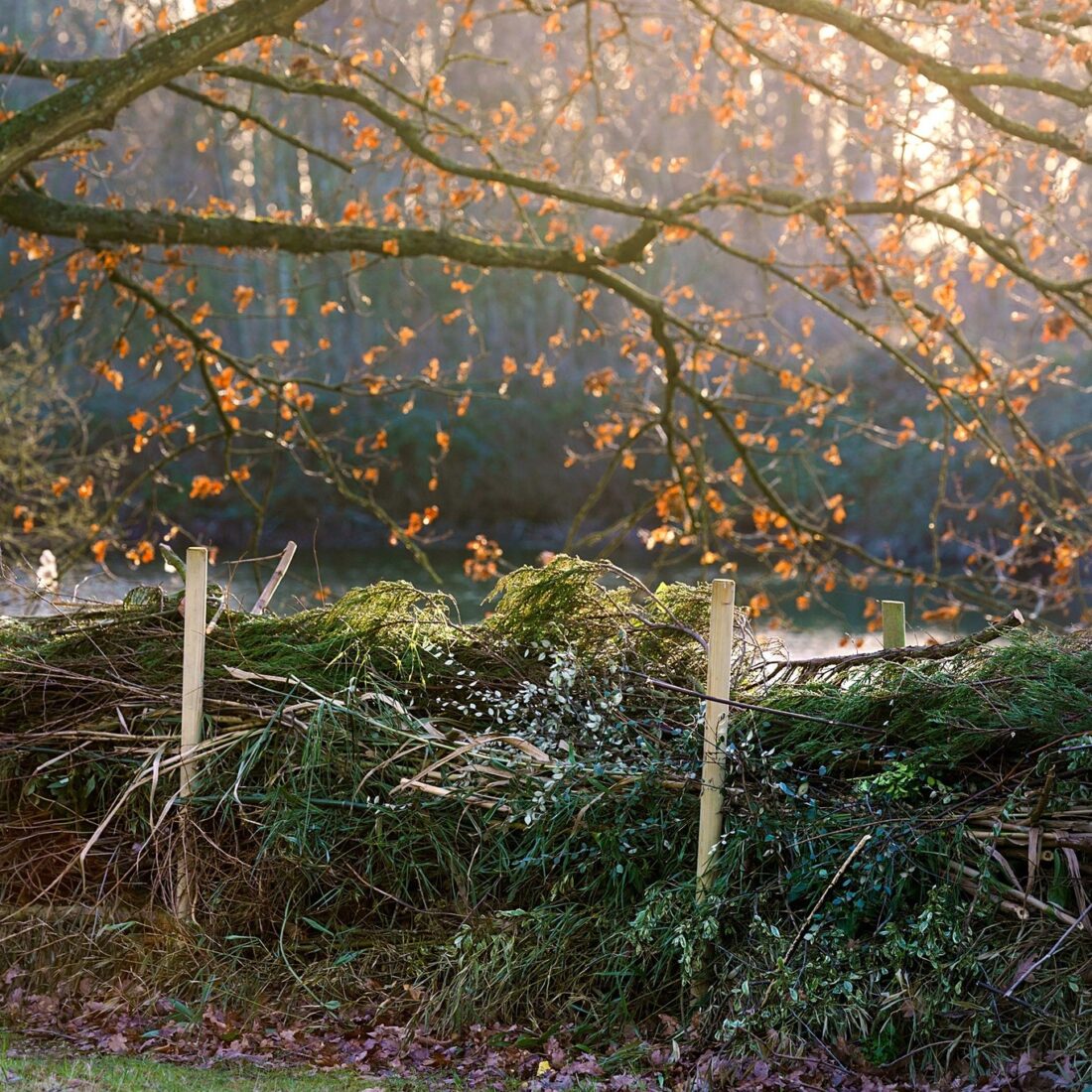
Why a Dead Hedge?
I live in a place where fences aren’t really a thing. Old stone walls crisscross the land, marking boundaries from centuries ago, but with six acres, maintaining suburban-style divisions isn’t practical. Normally, the woods serve as the best kind of privacy screen—until, of course, a psychotic logger comes through with a chainsaw and no sense of self-preservation.
(And yes, I’ll remind you that this guy was cutting massive trees, in the dark, with no clear direction, while they fell towards my driveway, brushing against our power lines. The fact that this didn’t end in an even greater catastrophic disaster was sheer luck.)
So, how do you rebuild a natural barrier when fences aren’t the answer?
Enter dead hedges—a centuries-old, low-tech, zero-cost solution that turns garden waste into a living, breathing boundary.
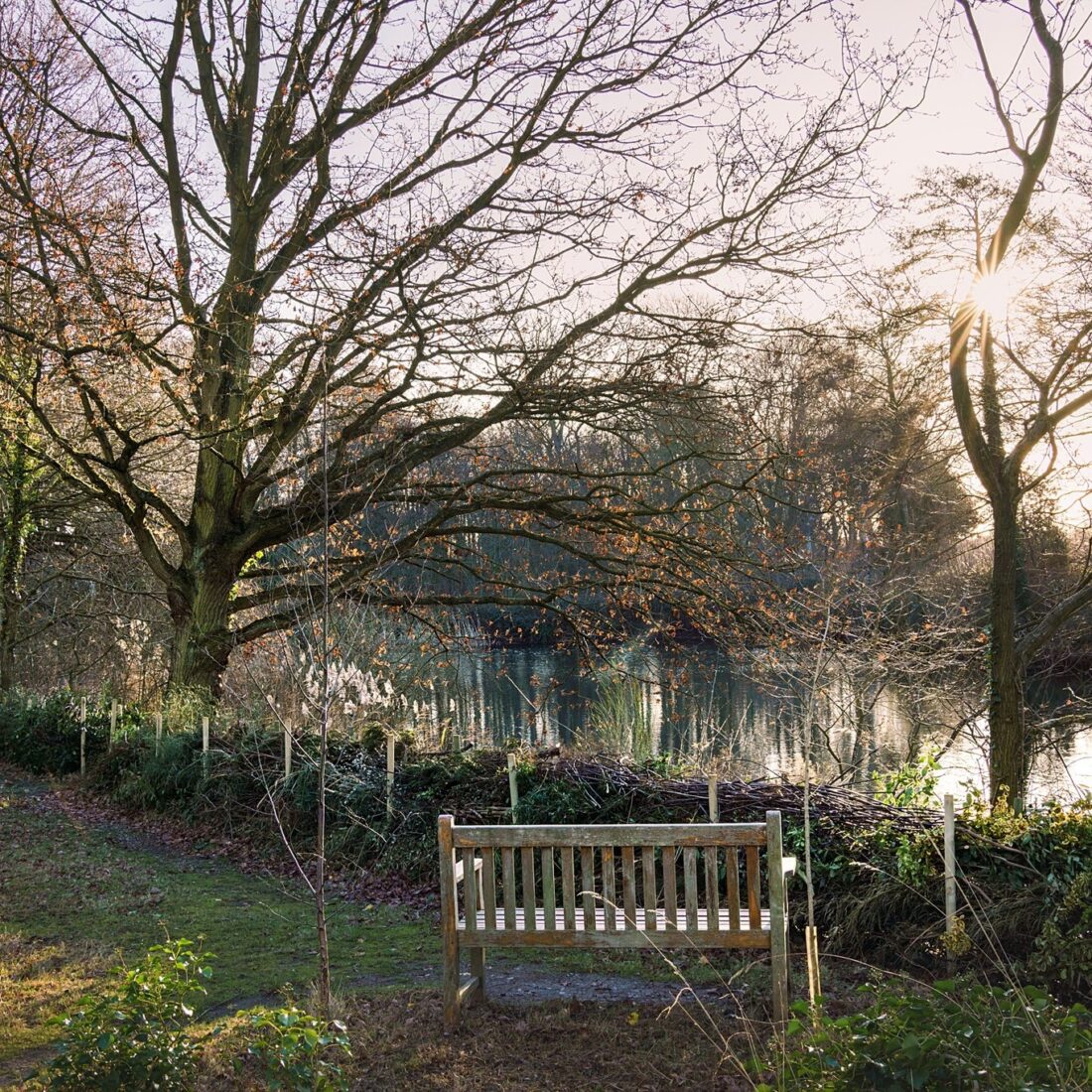
What is a Dead Hedge?
A dead hedge is essentially a woven or stacked barrier made from branches, logs, and pruned plant material. Unlike a traditional hedge, which takes years to grow, a dead hedge instantly provides structure, privacy, and habitat for wildlife. Over time, it breaks down, enriching the soil and supporting new growth.
Think of it as a way to put discarded branches to work—a living fence made of dead material.
Why Build a Dead Hedge?
After what happened to my landscape, a dead hedge made perfect sense. It’s:
- A visual and psychological buffer. I don’t have to see my neighbor’s clear-cut disaster, and I can start feeling a little more at peace in my own space.
- An instant barrier without needing a fence. Perfect for large properties where fencing everything would be impractical.
- A sustainable way to deal with all the branches and debris left from the tree loss. Instead of hauling them away or chipping them, I can reuse them right on site.
- A wildlife haven. It creates shelter for birds, insects, and small mammals, which are already returning to the area.
- A soil-building strategy. As the hedge breaks down, it feeds the earth beneath it, helping to regenerate what was lost.
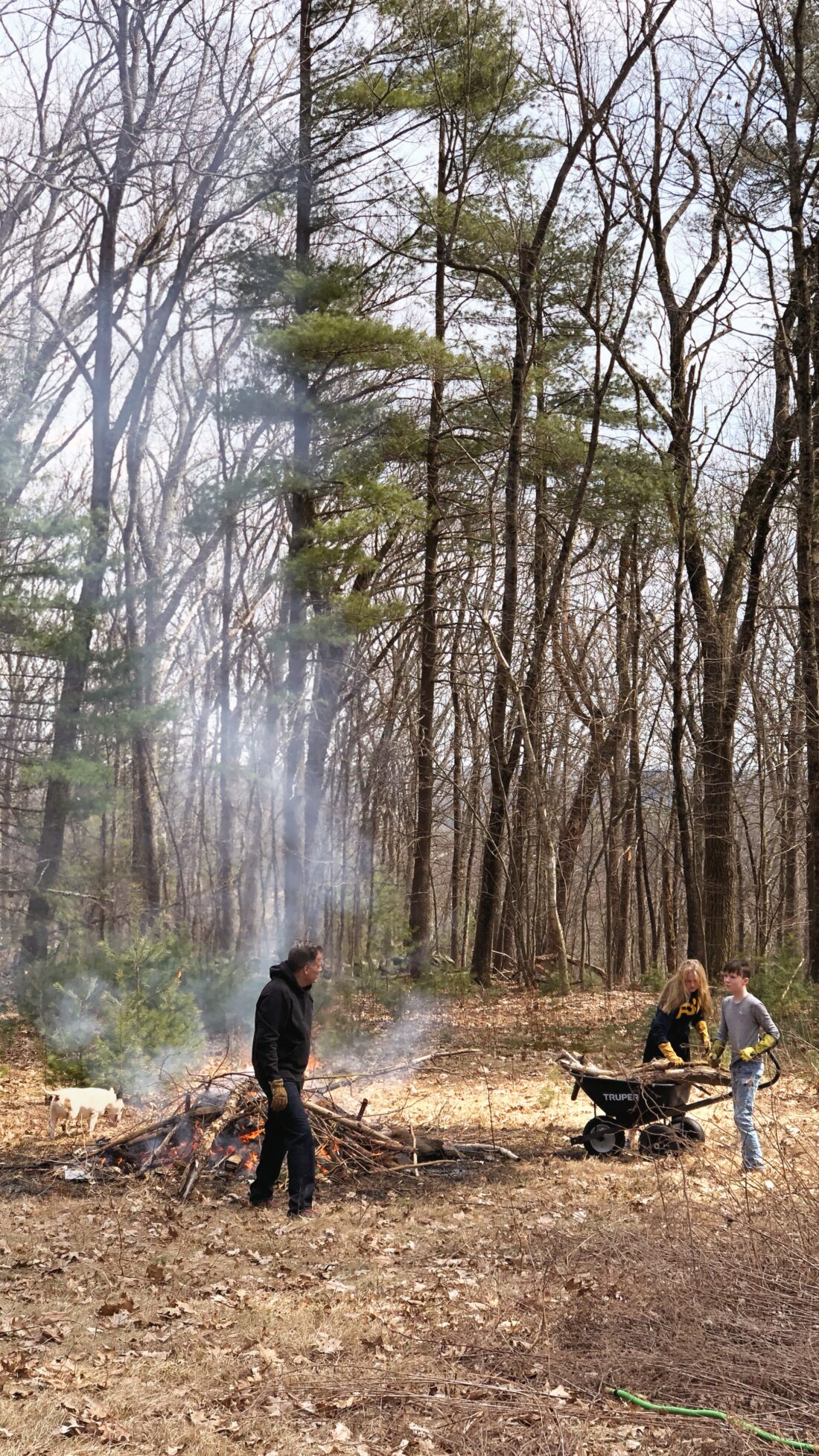
Why a Dead Hedge Feels Better Than a Burn Pile
In New England, spring means burning season—the traditional way to dispose of fallen branches and tree debris. But I’ve never loved it. Burning piles of branches is:
- Exhausting – It’s an all-day process of hauling, feeding the fire, and managing the burn.
- Stressful – There’s always that slight anxiety about wind, smoke, and embers.
- Smelly – After a day of burning, my hair, skin, and clothes feel completely fried.
- Inefficient – We have to haul everything to one central burn pile, which, given that we live on a hilltop property, means endless trekking up and down with armfuls of sticks.
With the dead hedge, we don’t have to haul anything as far. We simply move branches to the nearest property edge and stack them there. Less effort, better results.
Unlike a pile of ashes, the hedge feels like something lasting. I’ve read that you can expect a dead hedge to last 3-5 years, but I’ve decided that is nonsensical internet echo chamber information. The reality is that this is something that we will continue to add to over the years. There will always be spring cleanup debris and prunings. This is a long-term feature.
A Structure That’s Motivating and Evolving
There’s something about the sculptural nature of a dead hedge that’s unexpectedly motivating. As I build it, I see it take shape, and it makes me want to keep going. Even now, as I write this, over six inches of heavy, wet snow has fallen last night—I can’t even see half the branches buried beneath it—and yet I’m itching to get back outside and build more.
Now that I have a designated place for prunings, I find myself thinking differently about the maintenance of our fruit trees, shrubs, and perennials. The hedge gives purpose to everything I trim back—nothing is wasted.
There’s also something deeply satisfying about creating lines. I love a good string line when designing a garden, and there’s something about stretching to reach a goal, making something structured out of chaos, that feels right. And, of course, there’s the satisfaction of knowing my neighbor will see it.
I can’t wait for him to comment on it—or actually, I can. I don’t ever want to speak to him again.
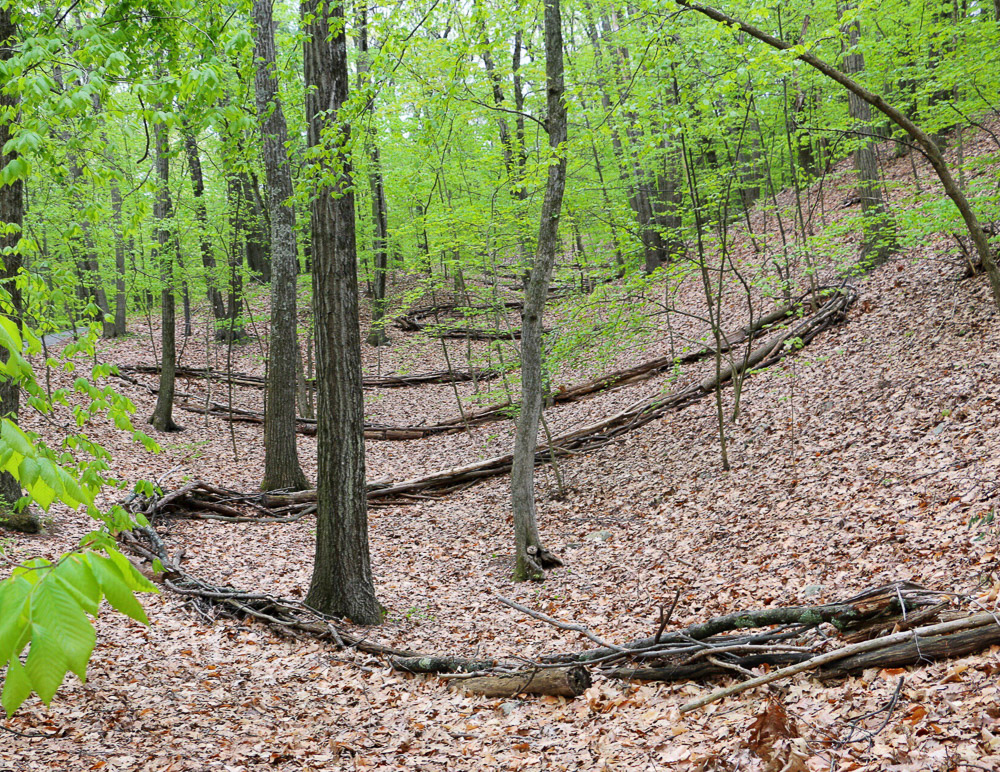
Inspiration from a Beautiful Dead Hedge in Massachusetts
The inspiration for all of this? A stunning dead hedge sculpture at the Native Plant Trust’s Garden in the Woods in Framingham, MA. When I first saw it, I was struck by how organic yet architectural it looked—functional, yet beautiful. It made me realize that dead hedging isn’t just about waste management—it can be an art form.
And now, standing at the edge of my property, looking at this growing hedge of twisted branches and woven limbs, I can’t help but feel like I’m building my own living sculpture.
It’s a barrier, a restoration project, a creative outlet, and a bit of a defiant statement all rolled into one.
Have you ever built a dead hedge? If not, I highly recommend it—for the land, for the wildlife, and for your own peace of mind.
How to Build a Dead Hedge
If you’ve got downed branches, logs, or pruned plant material, you can build a dead hedge—no special tools, no fancy skills required. Here’s how:
Step 1: Choose Your Location
For me, it was obvious—I needed a barrier between my land and the neighboring wasteland. But dead hedges can also be used to:
- Divide areas of a large garden
- Create windbreaks
- Provide a privacy screen
- Mark out pathways or wildlife corridors
- They can also be purely sculptural art forms
Step 2: Gather Materials
- Sturdy stakes or posts (wooden stakes, repurposed logs, or even metal posts for extra stability)
- A mix of large and small branches, logs, and twigs
- Leaves and organic matter to fill gaps
- I should note that I didn’t use the stakes (yet), which makes for a wider base (because it is more of a pyramidal form). I have plenty of space to let this be looser.
Step 3: Build the Structure
- Drive the stakes into the ground about 2-4 feet apart in two parallel rows.
- Stack branches and logs between the rows, starting with the largest pieces at the bottom.
- Layer in smaller twigs, leaves, and brush, weaving them into the structure for stability.
- Continue adding material over time, topping it up as it settles.
Step 4: Let Nature Take Over
- Over time, plants and fungi will colonize the hedge.
- You can encourage climbing plants like honeysuckle or native vines to soften it.
- Consider adding wildflowers or other plants around the base to support pollinators. (I’m not doing this – I am letting mine create contrast between the organized and the wild – it snakes through woods and the woodland plants will persist.
The Result? A Living, Breathing Barrier
Even after just a few months, I can already see the dead hedge blending into the landscape. Birds have started using it for shelter, and I’m noticing seedlings popping up around the base. Instead of staring at a harsh, open expanse, I now have something functional and restorative.
I can’t undo what happened to those trees, and I certainly can’t make my neighbors any less of a disaster. But I can rebuild my space in a way that feels right—with nature, rather than against it.
If you’ve ever dealt with loss of trees, unwanted exposure, or just an abundance of branches that need a purpose, a dead hedge might be worth trying.
Have you built a dead hedge before? I’d love to hear about your experience.
A dead fence as a living border – what a creative and sustainable answer to a disaster! 🌿 Instead of leaving behind burnt ground, the destruction is transformed into something useful and beautiful. The structure made of branches, trunks and cuttings not only creates a visual barrier, but also a habitat for birds, insects and fungi. And honestly – as a passive-aggressive garden border against inconsiderate neighbors? Perfect. 😏
I can’t deny the passive-aggressive-ness makes me feel a little smug and better (as does the dead hedge – because I genuinely like the look).
I am new here. And you’ve probably answered this a hundred times. Were you, at least, able to recoup the money from the logs? I know it would be small comfort. I’m an old farm girl in a semi-rural community trying to return my postage stamp of yard to a pollinator and small animal haven with appropriate plantings and a north neighbor that uses glyphosate and mows everything to oblivion and south neighbor who doesn’t yard or garden.
Unfortunately, no. We hired a lawyer, but in the end, you can’t get blood from a stone (or an uninsured grifter with no assets and barely a home).
The neighbor thing is hard…and it sounds like you know the struggle too.
“Building a dead hedge is such a fantastic way to create a living barrier while also promoting biodiversity and healing the land! It’s amazing how this sustainable approach combines gardening with ecological restoration. I love the idea of using natural materials like branches, sticks, and twigs to create something that benefits both the environment and the garden.
I love everything about a natural barrier! My only issue would be the garbage it would collect with the wind and changing seasons. I also don’t live in the forest so it’s somewhat impractical. Thank you for sharing some inspirational pictures of a dead hedge. I want this in my life.
So far so good – I don’t have much garbage floating around – but it would be worth it to clean it up.